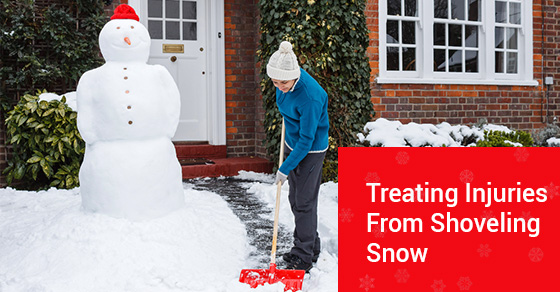Osteoarthritis Treatments: What You Need to Know...
Key Highlights: Osteoarthritis treatments focus on pain relief, restoring joint…
Read More
Posted by Dr. Scott Wilson | 16-Jan-2017
Winter can bring heavy snowfall, which requires residents to repeatedly shovel snow out of their driveways and walkways.
Although residents may be used to the annual snow shoveling season, many experience injury as a result of repetitive movements and improper use of their bodies.
Shoveling can lead to injuries that affect the neck, shoulders, arms, back and legs. Knowing how to prevent these injuries while shoveling snow keeps you safe and pain-free throughout the winter months.
Why injuries occur
Repetitive movements can put stress on the joints and connective tissues. Muscle imbalances and poor habits lead to faulty movement patterns that increase the risk of injury.
Shoveling requires you to raise your arms against resistance. Individuals who lack sufficient mobility through the spine and shoulder joints can find themselves in pain before long.
Common Injuries
Injuries from shoveling snow typically result from inflammation, impingement and undue pressure on connective tissues.
Rotator cuff tears can occur as a result of shoveling and can lead to instability of the shoulder. This increases the risk of future injury and can lead to chronic pain symptoms.
Other injuries occur when people slip on icy surfaces. Taking the right steps to avoid these issues is critical to protecting yourself from injuries.
Preventing injuries
Shovels create a disadvantage due to their length, which increases the load being placed on the body’s joints. The further a resistance is from your center of gravity, the more difficult it will be to move.
Learning how to lift with your leg muscles can protect your back and shoulders. Avoid standing in a flexed (bent over) position for long periods of time, and don’t shovel more than you can lift at one time. Regulating how much weight you lift and using proper techniques are essential to preventing injury while shoveling snow.
Keep the shovel as close your body as you can. This makes it easy to use larger and stronger muscles.
Your wrists can also be at risk of injury. Maintain a neutral position through the wrist joints when shoveling snow. Bending the wrist while lifting reduces its ability to work against resistance and can lead to trauma of the tissues.
It’s also important to have proper core function in order to stabilize the pelvis and spine. A skilled physiotherapist can assess your core strength and recommend exercises that improve function and prevent injury.
Shoveling snow can lead to unwanted injuries that keep you from meeting your personal and professional responsibilities. They can require extensive treatment or, in some cases, surgery.
Putting these steps in place ensures that your neck, shoulders, back and arms are protected this winter season so that you can stay healthy all year round.

Key Highlights: Osteoarthritis treatments focus on pain relief, restoring joint…
Read More
Key Highlights: Runner's knee, or patellofemoral pain syndrome, is a…
Read More
Key Highlights: Upper back and neck pain can be caused…
Read More
Key Highlights: Many people want to lose belly fat for…
Read More
Key Highlights: Vestibular physical therapy, or physiotherapy, is a specialized…
Read More
Key Highlights: Tennis elbow, or lateral epicondylitis, is a condition…
Read More